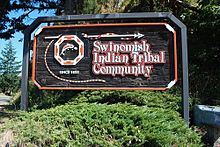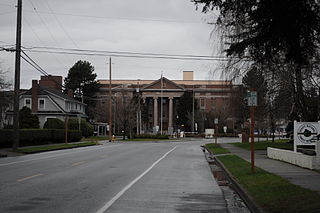
Skagit County is a county in the U.S. state of Washington. As of the 2020 census, the population was 129,523. The county seat and largest city is Mount Vernon. The county was formed in 1883 from Whatcom County and is named for the Skagit Indian tribe, which has been indigenous to the area prior to European-American settlement.

The Tulalip Tribes of Washington, formerly known as the Tulalip Tribes of the Tulalip Reservation, is a federally recognized tribe of Duwamish, Snohomish, Snoqualmie, Skagit, Suiattle, Samish, and Stillaguamish people. They are South and Central Coast Salish peoples of indigenous peoples of the Pacific Northwest Coast. Their tribes are located in the mid-Puget Sound region of Washington.

The Duwamish are a Lushootseed-speaking Native American tribe in western Washington, and the indigenous people of metropolitan Seattle, where they have been living since the end of the last glacial period. The Duwamish tribe descends from at least two distinct groups from before intense contact with people of European ancestry—the People of the Inside and the People of the Large Lake —and continues to evolve both culturally and ethnically. By historic language, the Duwamish are (Skagit-Nisqually) Lushootseed; Lushootseed is a Salishan language. Adjacent tribes throughout the Puget Sound-Strait of Georgia basin were, and are, interconnected and interrelated, yet distinct. Today, some Duwamish people are enrolled in the federally recognized Tulalip Tribes of Washington as well as the Muckleshoot Tribe.
Sauk-Suiattle, or Sah-Ku-Me-Hu, is a federally recognized Native American tribe in western Washington state in the United States. The tribe historically lived along the banks of the Sauk, Suiattle, Cascade, Stillaguamish, and Skagit rivers, in the area known as Sauk Prairie at the foot of Whitehorse Mountain in the North Cascade Range.

The SwinomishSWIN-ə-mish are an historically Lushootseed-speaking Native American people in western Washington state in the United States. The Tribe lives in the southeastern part of Fidalgo Island in northern Puget Sound, near the San Juan Islands, in Skagit County, Washington. Skagit County is located about 70 miles (110 km) north of Seattle.

The Pend d'Oreille, also known as the Kalispel, are Indigenous peoples of the Northwest Plateau. Today many of them live in Montana and eastern Washington. The Kalispel peoples referred to their primary tribal range as Kaniksu.

The Confederated Tribes of the Chehalis Reservation is a federally recognized tribe of Upper and Lower Chehalis, Klallam, Muckleshoot, Nisqually, and Quinault peoples. They are one of the Northern Straits branch Central Coast Salish peoples of indigenous peoples of the Northwest Coast. Their tribe is located in southwest Washington.
The Samish are a Native American people who live in the U.S. state of Washington. They are a Central Coast Salish people. Through the years, they were assigned to reservations dominated by other Tribes, for instance, the Swinomish Indians of the Swinomish Reservation of Washington and the Tulalip Tribes of the Tulalip Reservation. They are also enrolled in the Samish Indian Nation, formerly known as the Samish Indian Tribe, which regained federal recognition in 1996.

The Treaty of Point Elliott of 1855, or the Point Elliott Treaty,—also known as Treaty of Point Elliot / Point Elliott Treaty—is the lands settlement treaty between the United States government and the Native American tribes of the greater Puget Sound region in the recently formed Washington Territory, one of about thirteen treaties between the U.S. and Native Nations in what is now Washington. The treaty was signed on 22 January 1855, at Muckl-te-oh or Point Elliott, now Mukilteo, Washington, and ratified 8 March and 11 April 1859. Between the signing of the treaty and the ratification, fighting continued throughout the region. Lands were being occupied by European-Americans since settlement in what became Washington Territory began in earnest from about 1845.
The Lower Skagit are a tribe of the Lushootseed Native American people living in the U.S. state of Washington. Today they are enrolled in the federally recognized tribe, the Swinomish Indians of the Swinomish Reservation.
The Nisqually Indian Tribe of the Nisqually Reservation is a federally recognized tribe of Nisqually people. They are a Coast Salish people of indigenous peoples of the Pacific Northwest. Their tribe is located in Washington.
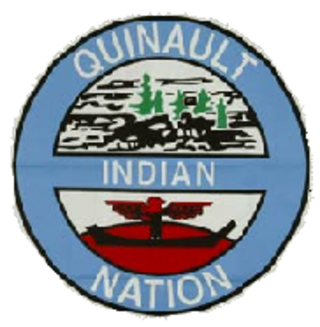
The Quinault Indian Nation, formerly known as the Quinault Tribe of the Quinault Reservation, is a federally recognized tribe of Quinault, Queets, Quileute, Hoh, Chehalis, Chinook, and Cowlitz peoples. They are a Southwestern Coast Salish people of indigenous peoples of the Pacific Northwest Coast. Their tribe is located in Washington state on the Pacific coast of the Olympic Peninsula. These peoples are also represented in other tribes in Washington and Oregon.

The Samish Indian Nation is a Coast Salish nation and a signatory to the Treaty of Point Elliott of 1855. Samish has a government-to-government relationship with the United States of America. The Samish are a Northern Straits branch of Central Coast Salish peoples. The Samish Nation is headquartered in Anacortes, Fidalgo Island, in Washington, north of Puget Sound.

The Skokomish Indian Tribe, formerly known as the Skokomish Indian Tribe of the Skokomish Reservation, and in its own official use the Skokomish Tribal Nation, is a federally recognized tribe of Skokomish, Twana, Klallam, and Chimakum people. They are a tribe of Southern Coast Salish indigenous people of the Pacific Northwest located in Washington. The Skokomish are one of nine bands of Twana people.

The Stillaguamish Tribe of Indians, formerly known as the Stillaguamish Tribe of Washington, is a federally recognized tribe of Stillaguamish people. They are a tribe of Southern Coast Salish indigenous people of the Pacific Northwest located in Washington.

The Kalispel Indian Community of the Kalispel Reservation is a federally recognized tribe of LowerKalispel people, located in Washington. They are an Indigenous people of the Northwest Plateau.
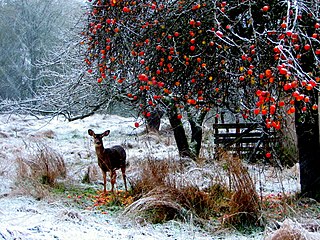
The Port Gamble S'Klallam Tribe, formerly known as the Port Gamble Indian Community of the Port Gamble Reservation or the Port Gamble Band of S'Klallam Indians is a federally recognized tribe of S'Klallam people, located on the Kitsap Peninsula in Washington. They are an Indigenous peoples of the Northwest Coast.

The Cowlitz Indian Tribe is a federally recognized tribe of Cowlitz people. They are a tribe of Southwestern Coast Salish and Sahaptan indigenous people of the Pacific Northwest located in Washington.

The Mitchell Bay Band of the San Juan Islands is an indigenous Coast Salish community based in the San Juan Islands of Washington, United States. The community was first referred to as the Mitchell Bay Tribe by Office of Indian Affairs agent Charles Roblin in his 1919 Census of Unenrolled Indians, in reference to one of several bays with historically significant indigenous populations.
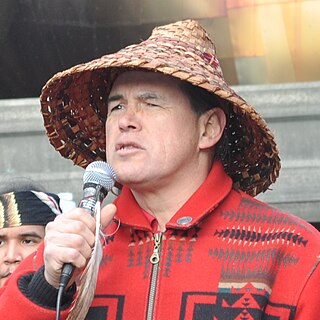
Brian Cladoosby is a Native American leader and activist. He served as chairman of the Swinomish Indian Tribal Community from 1997 to 2020 and was elected to his first of two terms as president of the National Congress of American Indians in October 2013. He previously served as president of the Affiliated Tribes of Northwest Indians.
